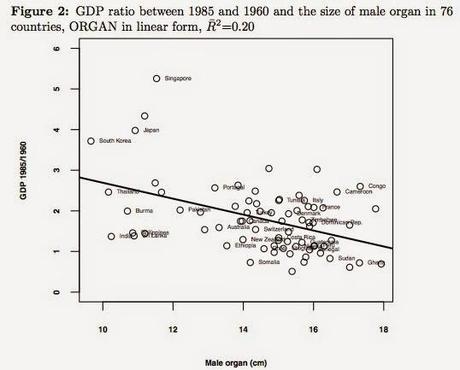
Aprovecho este #LunesPollas, iniciativa de Naukas, para dar a conocer un curioso ejercicio de encontrar correlaciones. Se trata del trabajo "Male Organ and Economic Growth: Does Size Matter?", de Tatu Westling, de la Universidad de Helsinki. Copio el abstract:
This study explores the link between economic growth and penile length between 1960 and 1985. It estimates an augmented Solow model utilizing the Mankiw-Romer-Weil 121 country dataset. The size of male organ is found to have an inverse U-shaped relationship with the level of GDP in 1985. Economic development between 1960 and 1985 is negatively associated with the size of male organ. With considerable reservations it is also found to be a more important determinant of GDP growth than country's political regime type. Two interpretations for the patterns between male organ and economic growth are discussed briefly: the link between penile length, testosterone and risk-taking, and selfesteem production. Despite the robust statistical links, until more rigorous treatments on the subject the proposed ‘male organ hypothesis’ should be taken with reservations.Como dice al final, tomemos la hipótesis con muchas reservas. De hecho, hay una importante: en los datos ofrecidos por el trabajo, el tamaño del órgano masculino es mayor en Francia. Según nos indican en Freakonomics, los datos de ese país están recogidos por fuentes francesas, mientras que en otros países las fuentes son más variadas. Recuerda a la abundancia de tres estrellas Michelin entre los restaurantes franceses en comparación con el resto del mundo.
-----------------------
Tal vez también te interese: #LunesTetas: Decisiones informadas sobre cáncer de mama.
-----------------------

